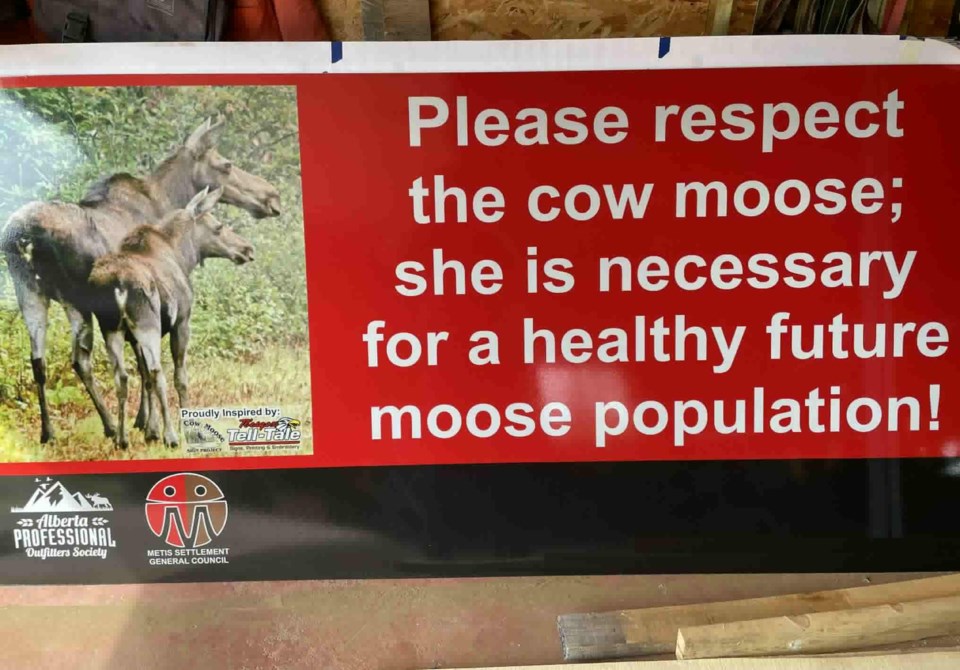LAKELAND - Concerns about the well-being of moose populations in the province have prompted the Alberta Professional Outfitters Society (APOS) to kickstart the Alberta Cow Moose Sign Project.
According to Bob Heyde, a member of APOS, the Alberta Cow Moose Sign Project comes as a result of concerns expressed by a number of the organization’s Alberta outfitters, especially those living in the northern half of the province.
Many outfitters believe they were witnessing a significant decline in moose populations in northern Wildlife Management Units (WMUs).
Heyde said it is very important for the public to understand that the decline in moose numbers is not happening across all of Alberta, and is largely a northern Alberta phenomenon.
This phenomenon is being noted in the Lakeland region.
“People in the Lakeland region - especially those who hunt moose - need to be made aware of the decline in moose numbers,” Heyde said, adding that the sign project has one objective - “To restore moose numbers in areas of decline to their rightful place on our landscape, for the benefit of future generations of moose hunters.”
Everyone must recognize the importance of allowing cows to reproduce, said Heyde. One cow moose, he explained, has the capacity of giving birth to as many as 20 calves in her lifetime.
“So, shooting a cow is effectively taking 20 potential moose out of a population,” he explained.
Through the Alberta Cow Moose Sign Project, APOS is working with eight Métis communities in northern Alberta, four of which are located in the northeastern region.
The four Métis settlements in northeastern Alberta that have signed on to be part of the project are Elizabeth Métis Settlement, Fishing Lake, Buffalo Lake, and Kikino.
The other northern Alberta Métis settlements that already have or will be putting up signs in their communities very soon are Gift Lake and Pea Vine Métis Settlements, along with East Prairie and Paddle Prairie.
The work involves distributing 4x8 signs to the settlements to be displayed as an educational tool regarding the preservation of cow moose populations.
These signs contain the words: ‘Please respect the cow moose; She is necessary for future healthy moose population.’
“It’s a picture of a cow and a calf moose,” Heyde said, describing the signs that people will see as they drive down the road, or while out hunting. “We are in the process of distributing signs all across northern Alberta.”
Last October, APOS made a presentation to the Métis Settlement General Council (MSGC), the umbrella organization for the eight Métis Settlements in Alberta.
Roy Auger, the harvesting chairperson, reviewed the data and information sent to him from APOS, and, in a unanimous vote, MSGC adopted the motion to support the Alberta Cow Moose Sign initiative, said Heyde.
“APOS offered to supply all eight settlements with 4X8 signs to bring awareness to this issue, and to encourage all hunters to refrain from harvesting cow/calf moose,” Heyde said. “Signs are also available for outfitters and residents to spread the message.”
According to APOS, population models consistently show that reductions in adult female survival are the most influential factor in moose population decline. Voluntary reductions in cow harvest, even in circumstances where it is legal are a precautionary approach that is supported by science.
Through the Alberta Cow Moose Sign Project, APOS wanted to verify that what the organization thought it was seeing in the field was reflected in the population estimates that fish and wildfire biologists generate.
APOS discovered that many of the WMUs did not have current data, but there were definitely significant downward trends in some WMUs.
Wanting to determine why this was happening, APOS hired an independent wildlife consultant firm called Omnia to review the current scientific data.
“Scores of studies were reviewed, and many studies confirmed our suspicions that in many areas of western Canada, moose populations have been declining,” he explained.
Omnia was unable to pinpoint a cause, but concluded that the following factors probably play a role - increased predation, loss of habitat, forestry, and over harvest.
“We’re counting on science to help us determine the causes, but at this point, we can’t make a definitive conclusion,” said Heyde.
A decade ago, Dan Simmons, an outfitter operating in northern British Columbia, become aware of the same problem with declining moose populations. Wildlife managers in the area, Heyde said, were intentionally issuing resident cow and calf harvesting licences in an effort to lower moose numbers as part of a caribou recovery strategy.
“Dan was able to successfully gather support from the First Nations bands in his area and lobby the provincial government to stop the cow/calf harvest,” Heyde said. “The Cow Moose Sign campaign was a direct result of Dan’s efforts, and there appears to be a slow but steady increase in numbers there.”
APOS recognizes that the success of this program is dependent on the participation of all moose hunters. He explained that the organization has reached out to the Alberta Wildlife Federation, and the Alberta Hunter Education Instructors Association.
“We look forward to the support . . . of all of the First Nations hunters as well. We are especially thankful for the immediate support of the Métis Settlements General Council,” he said.
Corey Jarvis, president of the Alberta Professional Outfitters Society, also praised the initiative.
“Our members have been raising concerns about moose populations in various areas of the province for several years,” said Jarvis. “Since outfitters return to the same locations year after year, they have a sense of how populations fluctuate and are deeply invested in the future of healthy moose populations in Alberta.”



